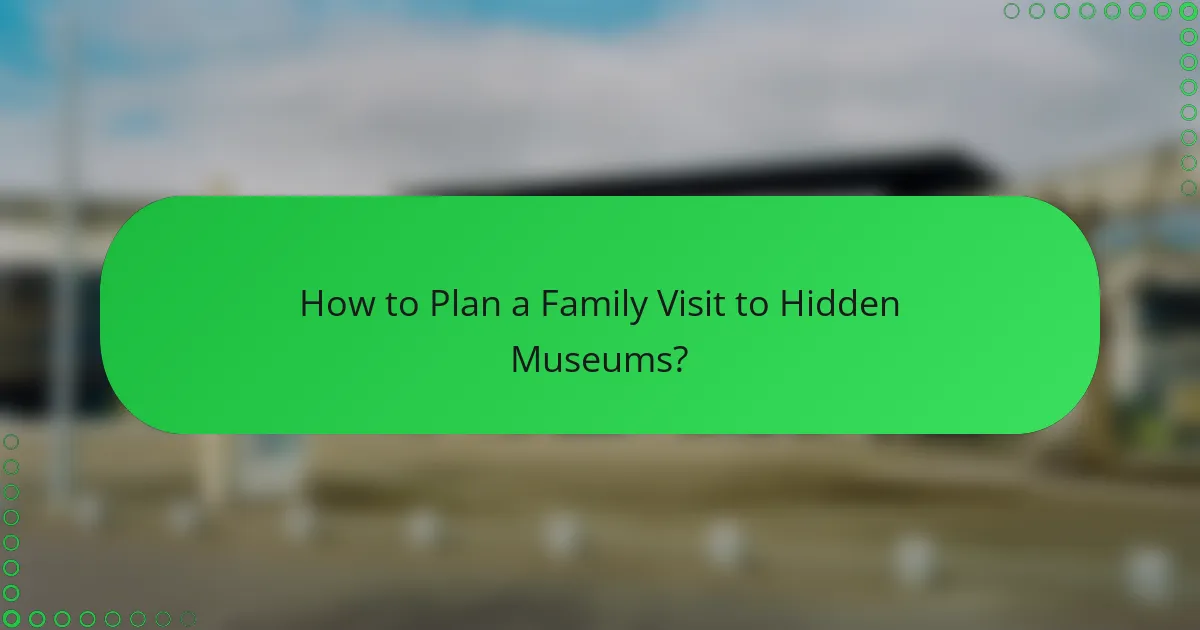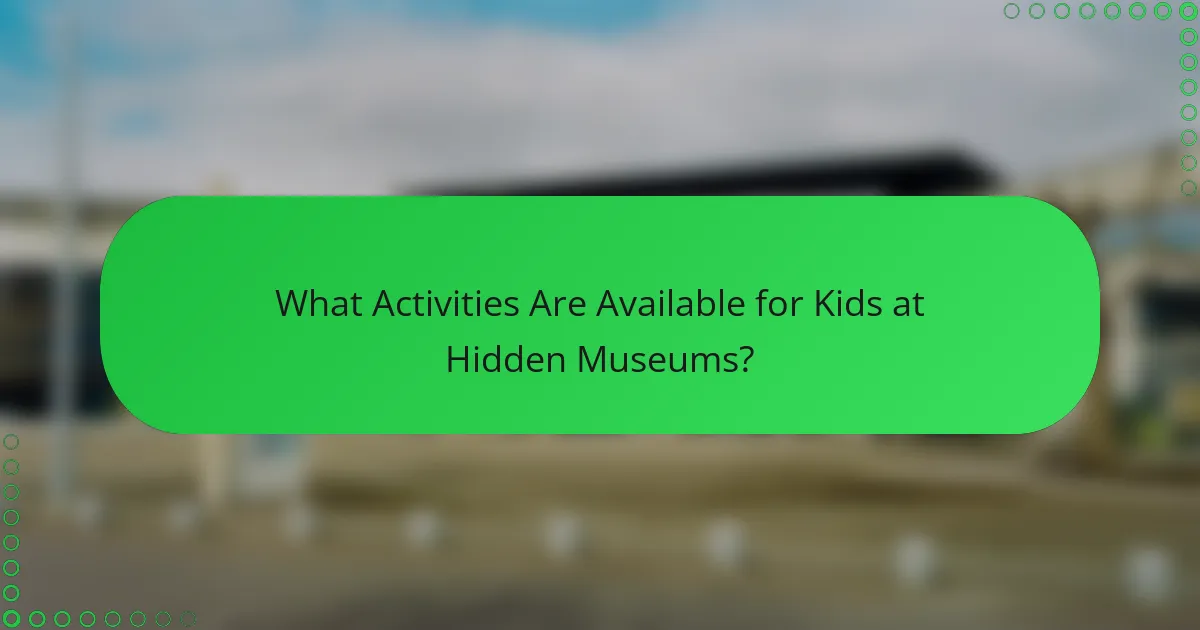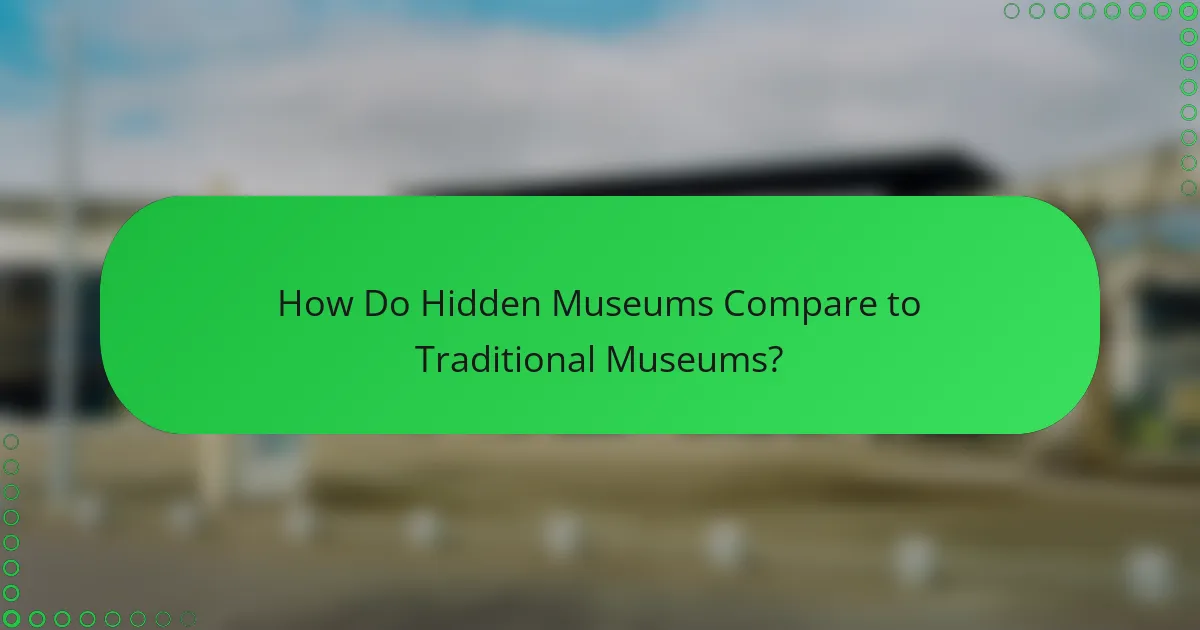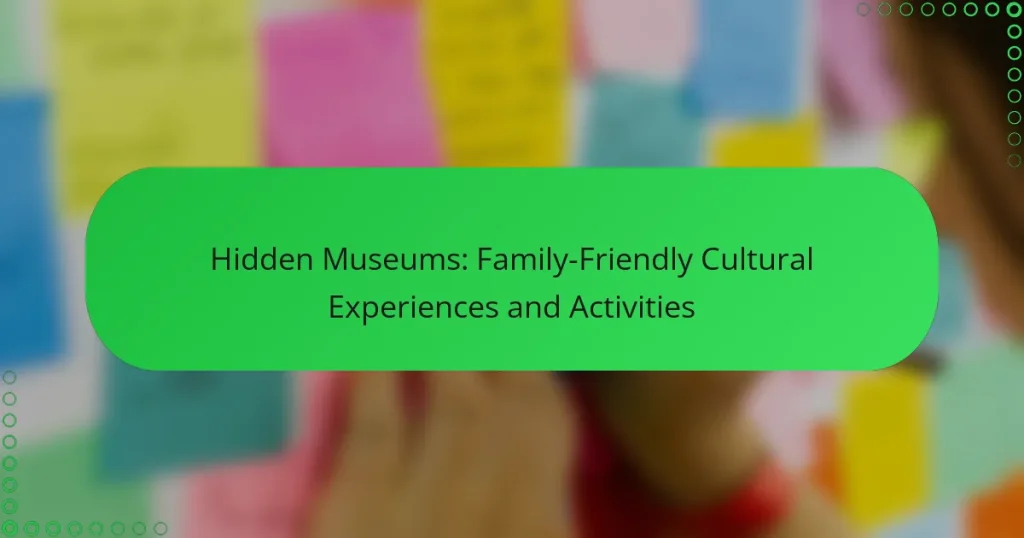Hidden museums present a treasure trove of cultural experiences perfect for families, blending education with fun. These unique venues often feature interactive exhibits and hands-on activities that captivate both children and adults, fostering curiosity and creativity. When planning your visit, consider accessibility and available programs to ensure an enriching experience for all ages.

What Are the Best Hidden Museums for Families?
The best hidden museums for families offer unique cultural experiences that engage children and adults alike. These venues often feature interactive exhibits, hands-on activities, and educational programs designed to spark curiosity and creativity.
Exploratorium in San Francisco
The Exploratorium is a hands-on science museum that encourages families to explore and experiment together. With over 600 interactive exhibits, children can engage in activities that cover topics like physics, biology, and art.
Consider visiting during weekdays to avoid crowds, and check their website for special family programs or workshops. Admission is around $30 for adults, while children under 3 enter for free.
Children’s Museum of Indianapolis
The Children’s Museum of Indianapolis is the largest children’s museum in the world, offering a variety of exhibits that cater to different age groups. Families can explore everything from dinosaurs to space exploration in a fun and educational environment.
Plan your visit to coincide with special events or seasonal exhibits, which often include interactive activities. Admission is approximately $20 for adults and $15 for children, with discounts available for members.
Smithsonian National Postal Museum
The Smithsonian National Postal Museum in Washington, D.C., provides a fascinating look at the history of mail delivery in the United States. Families can explore exhibits featuring historic mail vehicles, stamps, and interactive displays that explain the postal system.
Admission is free, making it an affordable option for families. Be sure to check for family-friendly programs and activities that may be offered during your visit.
California Academy of Sciences
The California Academy of Sciences in San Francisco combines an aquarium, planetarium, and natural history museum all under one roof. Families can enjoy a variety of exhibits, including a rainforest dome and a living roof.
Consider purchasing a family membership for savings on admission and special events. General admission is about $40 for adults and $30 for children, with discounts for residents of San Francisco.
American Museum of Natural History
The American Museum of Natural History in New York City offers a vast array of exhibits that cover everything from dinosaurs to human cultures. Families can participate in hands-on activities and explore the museum’s impressive planetarium.
Admission is suggested at $23 for adults and $13 for children, but you can pay what you wish. Check their calendar for family programs that enhance the experience, especially during weekends and holidays.

How to Plan a Family Visit to Hidden Museums?
Planning a family visit to hidden museums involves understanding their unique offerings and ensuring a smooth experience for all ages. Focus on accessibility, ticketing, and available programs to maximize enjoyment and learning opportunities.
Research museum hours and accessibility
Before visiting a hidden museum, check its operating hours, as they can vary significantly from larger institutions. Many hidden gems may only be open on specific days or have limited hours, so it’s crucial to confirm this information in advance.
Accessibility is another key factor. Look for details on wheelchair access, family restrooms, and any special accommodations for children or visitors with disabilities. Some museums may offer guided tours designed for families, which can enhance the experience.
Book tickets in advance
Booking tickets ahead of time is often essential for hidden museums, as they may have limited capacity. Many smaller venues offer online ticket sales, which can save time and ensure entry on busy days.
Consider checking for any family discounts or package deals that might be available. Some museums offer reduced rates for children or family groups, making it more affordable to explore together.
Check for family-friendly programs
Many hidden museums provide family-friendly programs, such as workshops, guided tours, or scavenger hunts designed for children. These activities can make the visit more engaging and educational for younger audiences.
Look for special events or seasonal programs that may coincide with your visit. Participating in these activities can enhance the overall experience and create lasting memories for your family.

What Activities Are Available for Kids at Hidden Museums?
Hidden museums often provide a variety of engaging activities specifically designed for kids, making cultural experiences enjoyable and educational. These activities typically include interactive exhibits, guided tours, and hands-on workshops that cater to children’s curiosity and creativity.
Interactive exhibits
Interactive exhibits are a staple in hidden museums, allowing children to engage directly with the displays. These exhibits often feature touchscreens, augmented reality, or physical installations that encourage exploration and participation. For example, a museum might have a dinosaur fossil dig site where kids can excavate replicas and learn about paleontology.
When visiting, look for exhibits that are age-appropriate and encourage teamwork, as many interactive displays are designed for group participation. This not only enhances learning but also fosters social skills among children.
Guided tours
Guided tours tailored for children can transform a standard museum visit into an exciting adventure. These tours often include storytelling elements, engaging narratives, and opportunities for questions, making the experience more relatable and fun. Some museums offer themed tours, such as “Mystery of the Ancient World,” which can captivate young imaginations.
Before attending, check if the museum requires advance booking for these tours, as they may have limited availability. Participating in a guided tour can also provide valuable insights that enrich the overall experience.
Workshops and hands-on activities
Workshops and hands-on activities are excellent ways for kids to learn through doing. Many hidden museums host regular workshops where children can create art, conduct science experiments, or participate in cultural crafts. These sessions often last from one to two hours and are led by knowledgeable instructors.
To maximize the experience, consider pre-registering for workshops, as they can fill up quickly. Additionally, check if there are any materials fees or age restrictions to ensure a smooth visit. Engaging in these activities not only reinforces learning but also allows children to take home a tangible reminder of their experience.

What Are the Benefits of Visiting Hidden Museums?
Visiting hidden museums offers unique advantages that enhance cultural experiences for families. These lesser-known venues often provide more personalized interactions, enriching educational opportunities, and a chance to discover local history and art in a more intimate setting.
Enhanced learning experiences
Hidden museums frequently focus on specific themes or local history, allowing for deeper exploration of subjects that may not be covered in larger institutions. Families can engage in hands-on activities, workshops, or guided tours that promote active learning and curiosity.
For instance, a small museum dedicated to local wildlife might offer interactive exhibits and educational programs tailored for children, making learning both fun and memorable. This targeted approach can significantly enhance a child’s understanding and appreciation of the subject matter.
Unique cultural exposure
These museums often showcase local artists, crafts, and traditions that are not represented in mainstream venues. By visiting hidden museums, families can experience authentic cultural expressions that reflect the community’s heritage.
For example, a museum featuring regional folk art may provide insights into local customs and practices, fostering a greater appreciation for diversity. This exposure can inspire creativity and broaden perspectives, especially for young visitors.
Less crowded environments
Hidden museums typically attract fewer visitors, creating a more relaxed atmosphere for families. This allows for easier navigation and more time to explore exhibits without the pressure of large crowds.
In a less crowded setting, children can ask questions and interact with staff or volunteers, enhancing their overall experience. Families can enjoy a more personal connection to the exhibits, making their visit more enjoyable and meaningful.

How Do Hidden Museums Compare to Traditional Museums?
Hidden museums offer unique cultural experiences that differ significantly from traditional museums. While traditional museums often feature well-known collections and large crowds, hidden museums provide intimate settings, specialized themes, and often interactive exhibits that engage families in a more personal way.
Unique Features of Hidden Museums
Hidden museums typically focus on niche subjects, such as local history, quirky art, or specific cultural artifacts. This specialization allows them to present collections that may not be available in larger institutions. For example, a hidden museum might showcase the history of a particular craft or the evolution of a local industry.
Many hidden museums also emphasize hands-on activities, making them particularly appealing for families. Children can often engage directly with exhibits, participate in workshops, or enjoy storytelling sessions that make learning fun and memorable.
Accessibility and Location
Hidden museums are often located in less-trafficked areas, which can make them more accessible to families looking for a quieter experience. They may be found in small towns or neighborhoods, sometimes in repurposed buildings like old factories or homes. This can provide a unique backdrop that enhances the overall experience.
However, accessibility can vary. Some hidden museums may have limited hours or require advance reservations, so it’s wise to check their websites or call ahead. Consider planning visits during off-peak times to avoid crowds and ensure a more enjoyable experience.
Cost Considerations
Admission fees for hidden museums can range from free to modest prices, often significantly lower than those of traditional museums. Many hidden museums operate on a donation basis or offer family discounts, making them budget-friendly options for cultural outings.
When planning a visit, check if there are any special events or workshops that may have additional costs. Some hidden museums also offer memberships that can provide savings for frequent visitors, so consider this if you plan to return.


